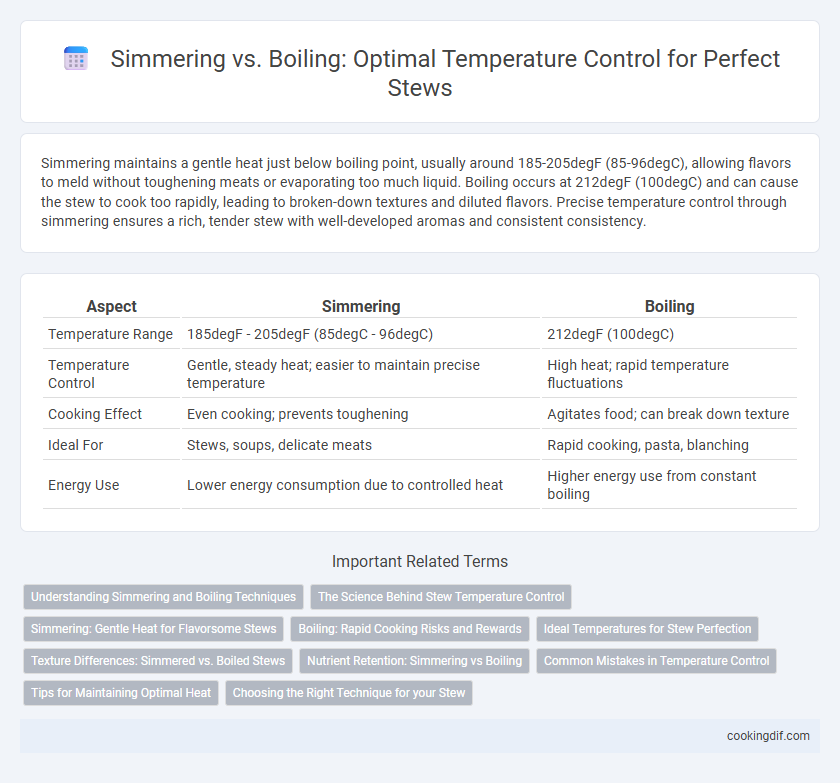Simmering maintains a gentle heat just below boiling point, usually around 185-205degF (85-96degC), allowing flavors to meld without toughening meats or evaporating too much liquid. Boiling occurs at 212degF (100degC) and can cause the stew to cook too rapidly, leading to broken-down textures and diluted flavors. Precise temperature control through simmering ensures a rich, tender stew with well-developed aromas and consistent consistency.
Table of Comparison
| Aspect | Simmering | Boiling |
|---|---|---|
| Temperature Range | 185degF - 205degF (85degC - 96degC) | 212degF (100degC) |
| Temperature Control | Gentle, steady heat; easier to maintain precise temperature | High heat; rapid temperature fluctuations |
| Cooking Effect | Even cooking; prevents toughening | Agitates food; can break down texture |
| Ideal For | Stews, soups, delicate meats | Rapid cooking, pasta, blanching |
| Energy Use | Lower energy consumption due to controlled heat | Higher energy use from constant boiling |
Understanding Simmering and Boiling Techniques
Simmering maintains a temperature range of 185degF to 205degF (85degC to 96degC), allowing gentle bubbles to rise slowly and evenly, which is ideal for tenderizing tough meat in stews without breaking down ingredients too rapidly. Boiling occurs at 212degF (100degC), producing rapid, rolling bubbles that can cause aggressive agitation, potentially toughening meat and causing ingredients to disintegrate. Mastering simmering versus boiling techniques ensures precise temperature control for optimal texture and flavor development in stew preparation.
The Science Behind Stew Temperature Control
Simmering stew maintains a consistent temperature between 185degF and 205degF, allowing collagen in meat to break down gently and evenly, resulting in tender texture. Boiling at 212degF causes rapid bubbling that agitates ingredients, which can toughen meat fibers and cloud the broth. Precise temperature control using simmering ensures optimal flavor extraction and nutrient retention during the slow cooking process of stew.
Simmering: Gentle Heat for Flavorsome Stews
Simmering maintains a consistent temperature range of 185degF to 205degF (85degC to 96degC), preventing the vigorous bubbles of boiling that can break down delicate ingredients and cloud the broth. This gentle heat allows flavors to meld gradually, resulting in a rich, tender stew with enhanced depth and clarity. Precise temperature control during simmering preserves texture and maximizes the infusion of spices and aromatics.
Boiling: Rapid Cooking Risks and Rewards
Boiling stew involves maintaining the liquid at 212degF (100degC), which accelerates cooking by rapidly breaking down tough meat fibers and softening vegetables. However, this high temperature can cause overcooking, resulting in dry, tough meat and mushy vegetables, compromising texture and flavor. Balancing boiling's speed with careful timing is essential to harness its benefits while avoiding the risks of nutrient loss and uneven cooking.
Ideal Temperatures for Stew Perfection
Stewing requires maintaining an ideal temperature range between 185degF to 205degF (85degC to 96degC) to achieve tender, flavorful results by allowing collagen breakdown without toughening proteins. Simmering, typically at 185degF to 205degF, ensures gentle cooking with consistent heat penetration, preserving texture and enhancing flavors, whereas boiling at 212degF (100degC) can cause rapid agitation that toughens meat and breaks down vegetables excessively. Precise temperature control through simmering is essential for stew perfection, balancing thorough cooking with optimal ingredient integrity.
Texture Differences: Simmered vs. Boiled Stews
Simmering stew at a temperature between 185degF and 205degF allows proteins to break down slowly, resulting in tender, melt-in-your-mouth textures. Boiling stew at 212degF causes rapid agitation that breaks down meat fibers too quickly, often making them tough and grainy. Controlled simmering preserves the stew's richness and consistency, enhancing flavor absorption and overall mouthfeel.
Nutrient Retention: Simmering vs Boiling
Simmering stew at temperatures between 185degF and 205degF preserves more nutrients by minimizing nutrient leaching compared to boiling, which occurs at 212degF and can break down vitamins and minerals. The gentler heat of simmering maintains the stew's nutritional value, especially water-soluble vitamins like vitamin C and B-complex. Boiling accelerates nutrient loss due to harsher temperature and agitation, making simmering the preferred method for nutrient retention in slow-cooked dishes.
Common Mistakes in Temperature Control
Common mistakes in temperature control during stew preparation include boiling at too high a temperature, which causes tough meat and broken-down vegetables, instead of maintaining a gentle simmer around 185-205degF (85-96degC). Many cooks confuse boiling (212degF/100degC) with simmering, leading to rapid evaporation and uneven cooking. Proper temperature control ensures flavors meld slowly without overcooking or separating ingredients.
Tips for Maintaining Optimal Heat
Maintaining optimal heat during stew preparation requires keeping the temperature between 185degF and 205degF for simmering, which allows flavors to meld without toughening meat. Using a heavy-bottomed pot ensures even heat distribution, preventing hot spots that cause boiling. Adjust the stove's heat gradually and monitor the liquid's surface, aiming for small, gentle bubbles to maintain consistent simmering.
Choosing the Right Technique for your Stew
Maintaining precise temperature control is crucial when making stew, as simmering typically occurs between 185degF and 205degF, ensuring gentle cooking that preserves texture and melds flavors. Boiling reaches 212degF, which can cause toughening of meat and cloudy broth due to vigorous agitation. Choosing simmering over boiling enhances the stew's richness and tenderness, delivering a deeper, more balanced taste.
Simmering vs boiling for temperature control Infographic

 cookingdif.com
cookingdif.com